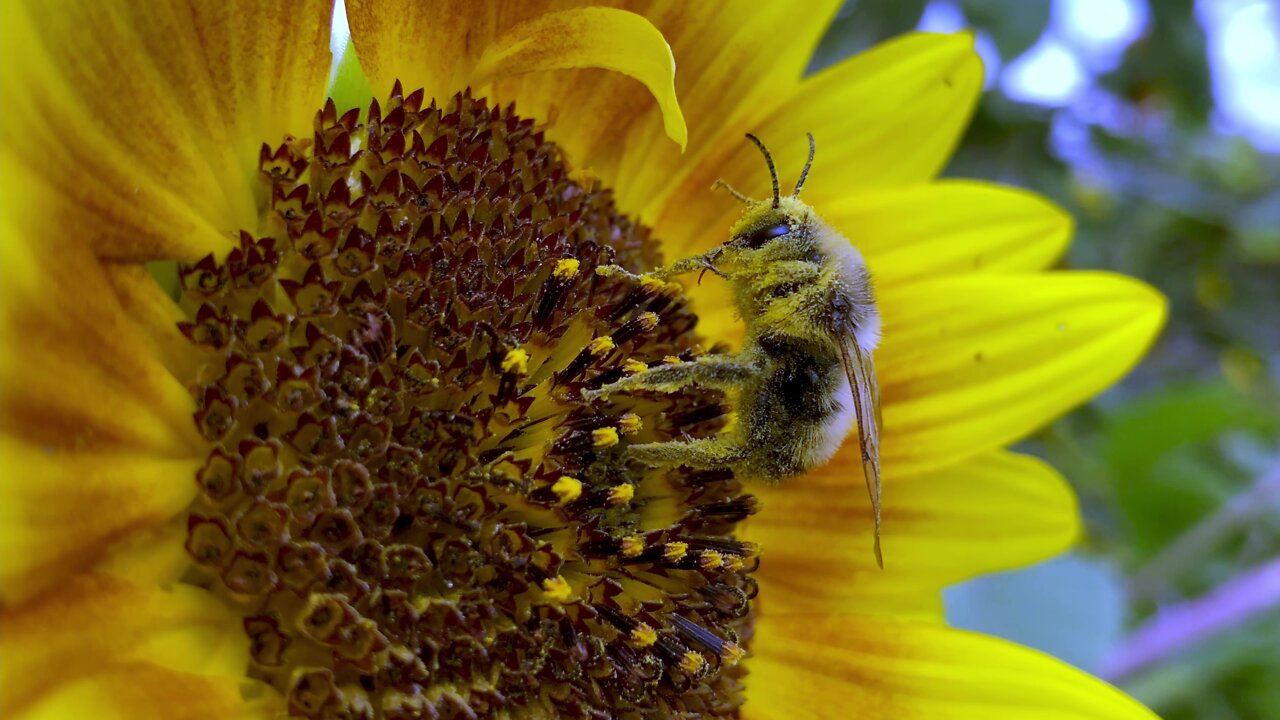Premium Only Content

Busy bumblebee is completely covered in pollen as she works
Bumblebees are very hardworking little creatures. Like honeybees, they are attracted by coloured flowers where they drink nectar and gather pollen for honey production. Like honeybees, bumblebees are important pollinators. As they gather pollen and nectar, they brush against various parts of the flowers, pollenating in the process.
There are approximately 250 species of bumblebees in the world. They prefer more temperate climates such as those found in Europe and North America, although some species can be found in more tropical regions. Their colonies consist of as few as 50 many as 400 individuals, which is much less than the colonies of honeybees. They are social animals and they cooperate to find food and care for others in the nest.
Bumblebees are remarkably intelligent compared with most insects, having been found to possess the ability to learn by observation. In studies where bees were given a food reward for moving a heavy object, they learned more quickly if they were able to see other bees complete the task first. The bees that observed the object being moved by a magnet also learned, but significantly less quickly than those bees that watched another bee move the object.
In a bumblebee colony, only the queen survives the winter. The workers and drones perish when the weather turns cold. The queen emerges and lays eggs that are fertilized by sperm that she has stored from mating the year before. The queen can lay fertilized eggs that hatch into female workers, or unfertilized eggs that hatch into male drones. She cares for and feeds the larvae until they hatch. She feeds them nectar for carbohydrates and pollen for protein. The larvae will need both to thrive.
Once enough workers hatch and mature, they will take over the duties of gathering food and caring for the larvae. The queen spends her time laying more eggs. Worker female bumblebees can also lay eggs, but they will only develop into drone males. The males have only one set of chromosomes, as opposed to females that have two sets. Only the queens can lay diploid female eggs. The queen will limit the worker bees' ability to lay eggs through physical aggression and pheromones.
Bumblebees are capable of foraging 1-2 km (1 mile) from their nest and they can reach speeds of up to 54km/h (35mph).
Queens and female bumblebees are capable of stinging, although most bumblebees are not aggressive and it is unlikely that a bee will sting a human unless handled excessively. The world of bees is a fascinating one and biologists are learning more about these incredible creatures each day. We now understand that bees are vital to the health and survival of most plants and that without them, our planet would be doomed.
-
 0:28
0:28
WildCreatures
2 months ago $1.24 earnedBaby Capybara Yawns and Falls Asleep Under His Mother's Watchful Eye
4.93K3 -
 1:07:25
1:07:25
Man in America
16 hours agoThe BRICS War on the Dollar Just Hit Endgame—What's Next Changes EVERYTHING
47K15 -
 3:23:45
3:23:45
SOLTEKGG
7 hours ago🔴LIVE - Community Game Night - GIVEAWAY
35.4K2 -
 8:22:30
8:22:30
SpartakusLIVE
9 hours ago#1 Friday Night HYPE, viewers GLUED to the screen
60.6K -
 55:50
55:50
NAG Podcast
8 hours agoAda Lluch: BOLDTALK W/Angela Belcamino
27.6K2 -
 2:45:31
2:45:31
VapinGamers
5 hours ago $10.43 earnedKellan Graves - Fallen - Game Review and Game KeyGiveaway - !rumbot !music
26.5K -
 1:06:41
1:06:41
MattMorseTV
8 hours ago $40.93 earned🔴Trump PREPARES for WAR with VENEZUELA.🔴
52.6K71 -
 39:59
39:59
Clownfish TV
12 hours agoHollywood NO MORE! Animation Industry Will DIE First?! | Clownfish TV
30.2K2 -
 25:57
25:57
The Kevin Trudeau Show Limitless
2 days agoThe Sound Of Control: This Is How They Program You
75K22 -
 47:41
47:41
Sarah Westall
7 hours agoNew Actions by Insiders Never Seen in History – Bitcoin Moves Ahead w/ Andy Schectman
28K3